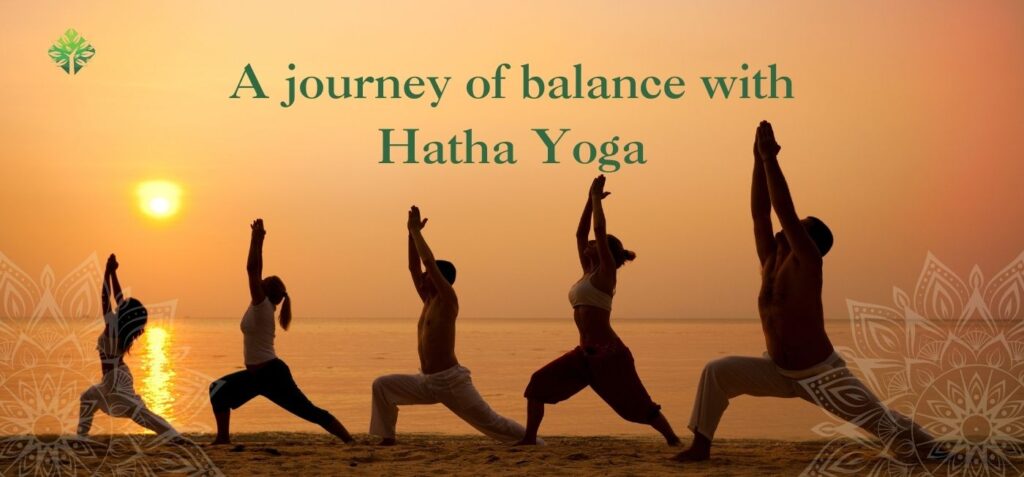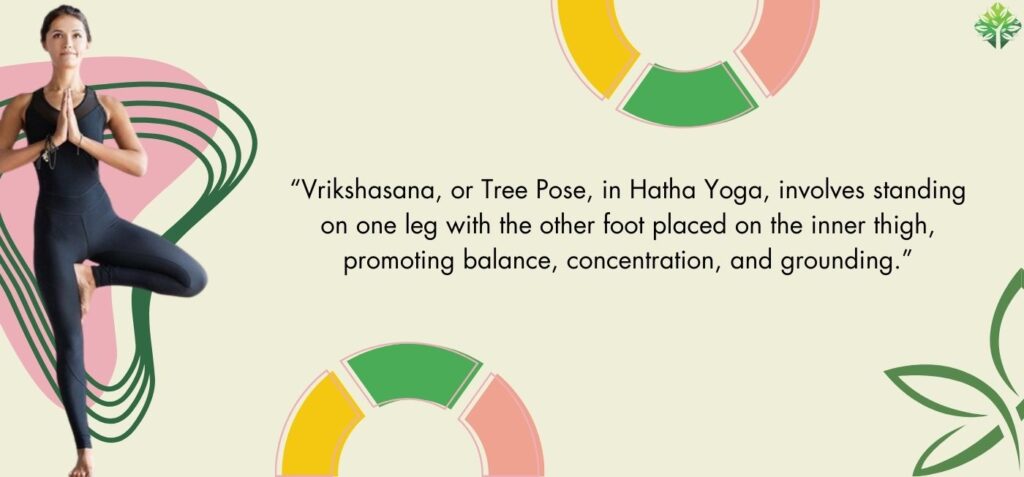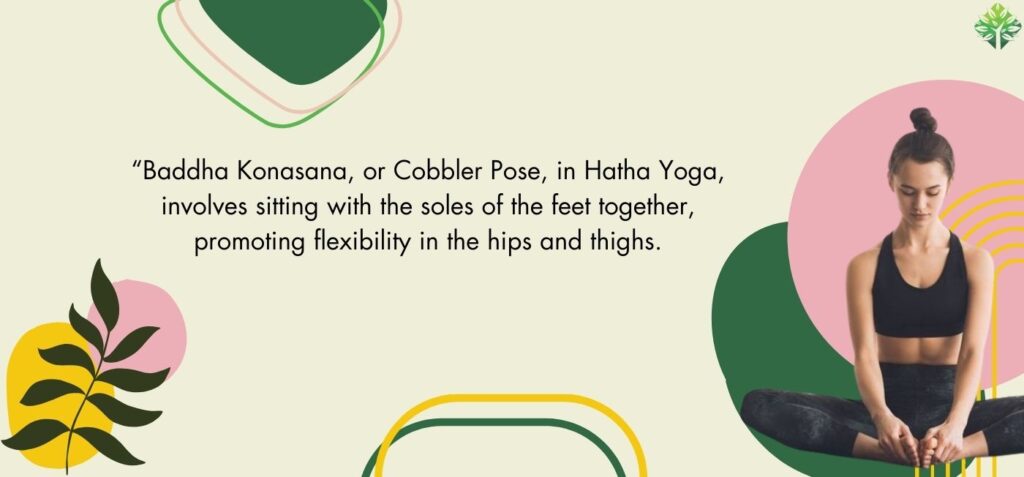Embracing balance - a journey into Hatha Yoga

Posted in : Admin
The name ‘Hatha Yoga’ holds a certain mystique, doesn’t it? It is not just a random combination of words; rather, it carries the essence of balance and duality inherent in this ancient practice. The term ‘Hatha’ is derived from the Sanskrit language, the ancient language of India. It is a composite of two root words – ‘ha’ and ‘tha,’ where ‘Ha’ represents the sun, and ‘Tha’ represents the moon. In the yogic philosophy, the sun and the moon are more than just celestial bodies; they embody opposing energies.
Before we delve into the asanas, benefits and principles of Hatha Yoga, let us take a brief look at the origin of Hatha Yoga.

History of Hatha Yoga
In the 15th century, Natha Yogis, eager to practice asanas, skipped the traditional order of mastering Yamas and Niyamas. This unconventional approach became known as ‘Hatha Yoga,’ emphasizing perseverance in mastering physical postures.
Swami Swatmarama complied with Hatha Yoga Pradipika, introducing a streamlined path to Samadhi by focusing on the physical aspect. Hatha Yoga, also termed as Shatanga Yoga, prioritizes starting with the body to ease the journey into mastering the mind, sidestepping the lengthy process of Yamas and Niyamas.
According to Swami Swatmarama, purifying the body is a practical entry point, as it aids in purifying the mind. This emphasis on holistic purification aligns with the central goal of Hatha Yoga – achieving and maintaining health as the foundation for spiritual development.
What does Hatha Yoga do to your body?
Hatha Yoga is capable of taking you beyond limitations through yogic postures. In the broader concept, Hatha Yoga is a physical technique, a crucial stepping stone towards loftier spiritual goals. It is readily available to the common man and has been practiced by regular people since immemorial, irrespective of caste and religion. The yoga regimen involves proper intake of nutritious food and breathtaking well apart from a routine of practicing asanas.
In a comprehensive study involving 2620 primarily female (84%) yoga practitioners, aged 31-60 (79%), various practice approaches were scrutinized. The majority (81%) had dedicated four or more years to yoga, with a prevalent preference for morning practice (65%). Reported benefits included heightened flexibility (87%), increased strength (77%), and mental, emotional and spiritual advantages.
Six principles of Hatha Yoga
Hatha Yoga, a profound system of physical and spiritual practices is guided by the following six principles.
Asanas (physical postures)
The foundation of Hatha Yoga lies in the practice of physical postures. Through intentional and mindful movement, practitioners enhance flexibility, strength and balance.
Pranayam (breath control)
The regulation of breath is crucial in Hatha Yoga. Pranayam techniques involve conscious control of the breath to enhance vital energy (prana), promoting a harmonious balance between body and mind.
Shatkarmas (purification techniques)
These are cleansing practices designed to purify the body and mind. Shatkarmas include techniques such as neti (nasal cleansing) and dhauti (cleansing of the digestive tract).
Mudras (gestures)
Mudras involve hand and body gestures that channel energy flow within the body. These symbolic movements contribute to the overall balancing of energies.
Bandhas (energy locks)
Bandhas are energy locks that help direct and control the flow of prana. Engaging specific muscle contractions assists in channeling energy throughout the body.
Meditation and relaxation
Hatha Yoga incorporates practices for mental well-being, including meditation and relaxation. These techniques foster a calm mind, inner awareness and a deeper connection to one’s spiritual self.
Hatha Yoga Asanas
Hatha Yoga, renowned for its physical postures or asanas, offers a diverse range of poses that contribute to overall well-being. Below mentioned are some of the fundamental Hatha Yoga asanas.

Vrikshasana (Tree Pose)
Vrikshasana, named after the Sanskrit word for tree, embodies the serene and steadfast nature of its arboreal counterpart. Unlike most asanas, this beginner-level pose demands open eyes for balance. Ideal for monitoring on an empty stomach, this pose requires just a minute of your time to cultivate its grounding benefits.
Benefit
In the practice of Vrikshasana, stability extends beyond the legs, bringing balance to the entire body while enhancing control over the nervous system. This post not only fortifies ligaments and tendons in the feet but also tones the buttocks and strengthens hip bones. Beyond the physical, Vrikshasana boosts self-confidence and esteem, sharpens concentration, fortifies the vestibular nervous system, and leaves you feeling revitalized. Embrace the holistic benefits of this empowering pose.
Tadasana (Mountain Pose)
Tadasana, known as the Mountain Pose, earns its title as the mother of all asanas, serving as the cornerstone for various yoga practices. Suitable for any time of the day, ensure an empty stomach if coupling it with other poses. This basic-level Hatha Yoga asana, when held for 10 to 20 seconds, lays the groundwork for optimal results in your practice. Embrace the simplicity and significance of Tadasana in your yoga journey.
Benefit
Tadasana works as a powerful tonic for your body. By strengthening knees, ankles and thighs, fosters stability and enhances posture. This pose injects vitality into your feet and legs, promoting improved blood circulation and tension release. Beyond the physical benefits Tadasana dispels depression, leaving you refreshed and uplifted. Embrace better posture, enhanced breathing, increased lung capacity, and a surge in energy levels through the empowering practice of Tadasana.
Adho Mukha Svanasana (Downward Facing Dog Pose)
Adho Mukha Svanasana mirrors a forward-bending dog, offering simplicity ideal for beginners. This introductory pose becomes a getaway to more advanced ones. Optimal practice occurs in the morning with an empty stomach for maximum benefits. As you ease into the pose, aim to hold it for 1 to 3 minutes. Embrace the ease of Adho Mukha Svanasana as it paves the way for a fulfilling yoga journey.
Benefit
Adho Mukha Svanasana extends your spine and tones muscles, fostering strength and flexibility. This pose enhances blood circulation to the brain, promoting mental calmness, alleviating headaches, insomnia and fatigue. Additionally, it acts as a natural remedy, reducing anxiety and depression. Engaging both arms and legs, Adho Mukha Svanasana emerges as a holistic practice, contributing to both physical and mental well-being.

Baddha Konasana (Cobbler Pose)
Baddha Konasana, the Cobbler Pose, echoes the imagery of a cobbler at work or a butterfly gracefully flapping its wings. This basic-level Hatha Yoga pose beckons practitioners to embrace serenity. Ideal for morning or evening practice on an empty stomach, with a recommended gap of 3-4 hours after a meal in the evening. Once assumed, hold the pose for 1 to 5 minutes, allowing the soothing benefits of Baddha Konasana to unfold in your yoga journey.
Benefit
The Cobble Pose, or Baddha Konasana, acts as a tonic for vital organs. This pose stimulates the heart, kidneys, bladder and abdominal organs, enhancing blood circulation. It brings relief by stretching the inner thighs and knees, combating fatigue. Beyond the physical, Baddha Konasana offers comfort during menstruation, aids in childbirth and alleviates menopausal symptoms.
Sethu Bandhasana (Bridge Pose)
Sethu Bandhasana or the Bridge Pose mirrors the structure of a bridge. This beginner-friendly background offers rejuvenation. The optimal practice time is in the morning on an empty stomach. For evening sessions, ensure a gap of 3-4 hours after a meal. Once in the pose, hold for 30 to 60 seconds, allowing the benefits of Sethu Bandhasana to resonate through your practice.
Benefit
Sethu Bandhasana, unfolds as a stretch for the neck and chest, fortifying the back. Beyond its physical benefits, this pose enhances digestion, reduces stress and alleviates headaches and backaches. It is an energizer for tired legs and a soothing balm for hypertension. In the realm of mental well-being, Sethu Bandhasana combats insomnia, calms nerves and acts as a gentle antidote for mild depression.
Ready to practice Yoga?
So, there you have it – a glimpse into the world of Hatha Yoga. It is not just about striking a pose; it is about finding balance, both on and off the mat. As you embark on your Hatha Yoga journey, savor the moments of stillness, relish the sensations in your body and embrace the transformative power of this ancient practice.
Yoga is known to have a calming effect on the body, and many poses have a stress-relieving effect. The balance and strength of the body combined with the focus on calming and clearing the mind reflect the mind and body unity, so, unsurprisingly, many people turn to this alternative therapy for healing.
Here is the opportunity to practice Gentle Hatha Yoga. Attain the union of mind-body-spirit through asanas (postures), breathwork and cleansing practices to help you amplify your power.
This workshop is designed to show how some of the main balance postures in Yoga can be done safely and easily. You will need a mat and some comfortable clothes. Remember, we have to start slow and work our way up.
Please note – Yoga is exercise; if you have any health issues, you should always check with your doctor before starting.
This workshop is designed for all work-from-home beings experiencing rigid body movement. We aim to get people to start stretching, moving and finding joy in their physical, emotional and spiritual being. Read more about the “Practicing Hatha Yoga for Beginners” workshop by visiting www.liftree.com.
